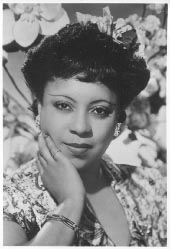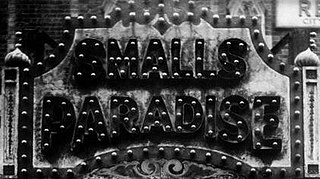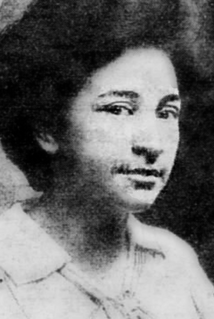Related Research Articles

The Cotton Club was a New York City nightclub from 1923 to 1940. It was located on 142nd Street and Lenox Avenue (1923-1936), then briefly in the midtown Theater District (1936-1940). The club operated during the United States' era of Prohibition and Jim Crow era racial segregation. Black people initially could not patronize the Cotton Club, but the venue featured many of the most popular black entertainers of the era, including musicians Fletcher Henderson, Duke Ellington, Jimmie Lunceford, Chick Webb, Louis Armstrong, Count Basie, Fats Waller, Willie Bryant; vocalists Adelaide Hall, Ethel Waters, Cab Calloway, Bessie Smith, Aida Ward, Avon Long, the Dandridge Sisters, the Will Vodery Choir, The Mills Brothers, Nina Mae McKinney, Billie Holiday, Lena Horne, and dancers such as Katherine Dunham, Bill Robinson, The Nicholas Brothers, Charles 'Honi' Coles, Leonard Reed, Stepin Fetchit, the Berry Brothers, The Four Step Brothers, Jeni Le Gon and Earl Snakehips Tucker.
Olu Dara Jones is an American cornetist, guitarist, and singer. He is the father of rapper Nas.

Leslie Marian Uggams is an American actress and singer. Beginning her career as a child in the early 1950s, Uggams is recognized for portraying Kizzy Reynolds in the television miniseries Roots (1977), earning Golden Globe and Emmy Award nominations for her performance. She had earlier been highly acclaimed for the Broadway musical Hallelujah, Baby!, winning a Theatre World Award in 1967 and the Tony Award for Best Actress in a Musical in 1968. Later in her career, Uggams received renewed notice with appearances alongside Ryan Reynolds in Deadpool (2016) and in a recurring role on Empire.

Adelaide Louise Hall was an American-born UK-based jazz singer and entertainer. Her long career spanned more than 70 years from 1921 until her death and she was a major figure in the Harlem Renaissance. Hall entered the Guinness Book of World Records in 2003 as the world's most enduring recording artist having released material over eight consecutive decades. She performed with major artists such as Art Tatum, Ethel Waters, Josephine Baker, Louis Armstrong, Lena Horne, Cab Calloway, Fela Sowande, Rudy Vallee and Jools Holland, and recorded as a jazz singer with Duke Ellington and with Fats Waller.
Lew Leslie was a Broadway writer and producer. Leslie got his start in show business in vaudeville in his early twenties.

Juanita Hall was an American musical theatre and film actress. She is remembered for her roles in the original stage and screen versions of the Rodgers and Hammerstein musicals South Pacific as Bloody Mary – a role that garnered her the Tony Award – and Flower Drum Song as Madame Liang.
Howard Eugene "Stretch" Johnson was a tap dancer and social activist.

Smalls Paradise, was a nightclub in Harlem, New York City. Located in the basement of 2294 Seventh Avenue, it opened in 1925 and was owned by Ed Smalls (né Edwin Alexander Smalls; 1882–1976). At the time of the Harlem Renaissance, Smalls Paradise was the only one of the well-known Harlem night clubs to be owned by an African-American and integrated. Other major Harlem night clubs admitted only white patrons unless the person was an African-American celebrity.
Ida Forsyne, sometimes seen as Ida Forcen, was an African-American vaudeville dancer who toured in Europe and Russia before World War I. Professionally she was known as the 'Queen of the Cakewalk'.

It Happened in Harlem is an American musical comedy film directed by Bud Pollard and starring Chris Columbus, Phil Gomez, and Nicky O'Daniel. The film was partly shot at Smalls Paradise and released in 1945.

Gerri Major (1894–1984) was an African-American woman who lived in Harlem during a career that stretched from the 1920s through the 1970s. She was successful in a number of overlapping vocations including journalist, editor, newscaster, publicist, public health official, author, and community leader. An article celebrating her 80th birthday said "Gerri was definitely one of the 'new Negroes' of the early 20th Century" adding that by the end of the 1930s she had become "one of the best known black women in America."

Club Harlem was a nightclub at 32 Kentucky Avenue in Atlantic City, New Jersey. Founded in 1935 by Leroy "Pop" Williams, it was the city's premier club for black jazz performers. Like its Harlem counterpart, the Cotton Club, many of Club Harlem's guests were white, wealthy and eager to experience a night of African-American entertainment.
The Golden Gate Ballroom, originally named the "State Palace Ballroom", was a luxurious ballroom located at the intersection of Lenox Avenue and 142nd Street in Harlem. It was allegedly the largest public auditorium in Harlem, with 25,000 square feet and a capacity of about 5,000 people on the dance floor in addition to several thousand spectators.

Jackie Robinson Park is a public park in the Hamilton Heights and Harlem neighborhoods of Manhattan in New York City. The approximately 12.77-acre (5.17 ha) park is bounded by Bradhurst Avenue to the east, 155th Street to the north, Edgecombe Avenue to the west, and 145th Street to the south. The park has baseball fields, basketball courts, restrooms, and a bandshell, which are arranged around the park's steep terrain. It also includes the Jackie Robinson Play Center, which consists of a recreation center and a pool. Jackie Robinson Park is maintained by the New York City Department of Parks and Recreation.
Juanita Boisseau, also known as Juanita Boisseau Ramseur, was an American dancer. She is best known for starring at the world famous jazz club Cotton Club in New York.
Ludie Olivia Jones was an American dancer. Jones was part of the Harlem Renaissance and started tap dancing at an early age. She had an early career that spanned the 1930s to the 1950s and was revived in the 1980s. Jones continued to dance and teach tap dance well into her later years.
Delilah Jackson was a cultural historian who specialized in collecting the history of black entertainers in Harlem.

Luisa Espinel, born Luisa Ronstadt, was an American singer, dancer, and actress. She toured, taught, performed on vaudeville, and appeared in a movie with Marlene Dietrich.

Cora Green was an American actress, singer, and dancer, billed as "The Famous Creole Singer".

Gertrude Elizabeth Curtis, also known as Gertrude Curtis McPherson, was an American dentist. She had a longtime practice in Harlem.
References
- 1 2 3 4 Finn, Joan (2004-05-27). "Hi-Steppin' at the Cotton Club". The Montclair Times. pp. B1. Retrieved 2020-04-15– via Newspapers.com.
- 1 2 Albrecht, Ernest (1984-09-16). "'Shades of Harlem': Jazz Revue Misses Atmosphere of Old Cotton Club". The Central New Jersey Home News. p. 77. Retrieved 2020-04-15– via Newspapers.com.
- ↑ Stratton-Johnson, Carolyn (1986-02-07). "'Shades of Harlem': Tribute to Past and Hope for the Future". The Paducah Sun. p. 2. Retrieved 2020-04-15– via Newspapers.com.
- 1 2 3 Andrews, Laura (1997). "'Shades of Harlem' Beautifully Captures Harlem of Yesteryear" . New York Amsterdam News. Retrieved 14 April 2020– via EBSCOhost.
- 1 2 Gussow, Mel (1984-08-22). "Stage: Music of the 20's in 'Shades of Harlem'". The New York Times. ISSN 0362-4331 . Retrieved 2020-04-15.
- 1 2 "Musical in 200th Staging". The Times-Tribune. 1985-03-03. p. 73. Retrieved 2020-04-15– via Newspapers.com.
- ↑ "Everyone Cottons to Our Roulette". Daily News. 1984-11-21. p. 16. Retrieved 2020-04-14– via Newspapers.com.
- 1 2 3 "Shades of Harlem in Woodstock". Rutland Daily Herald. 2004-02-27. p. 24. Retrieved 2020-04-15– via Newspapers.com.
- ↑ Finn, Joan (2002-11-07). "'Shades of Harlem,' The Cotton Club Musical, Opens at Tribeca". The Montclair Times. pp. B1. Retrieved 2020-04-15– via Newspapers.com.
- 1 2 3 O'Haire, Patricia (1984-08-22). "'Shades of Harlem' a Shadow of Real Thing". Daily News. p. 327. Retrieved 2020-04-15– via Newspapers.com.
- ↑ "'Shades of Harlem' Opens Off-Broadway". The Times-Tribune. 1985-03-03. p. 73. Retrieved 2020-04-15– via Newspapers.com.
- 1 2 Richardson, Alice (5 February 1998). "'Shades of Harlem' Shaking at the Schomburg" . New York Amsterdam News. 89 (6). p. 23. Retrieved 15 April 2020– via EBSCOhost.
- ↑ Kuchwara, Michael (1984-08-24). "'Shades of Harlem': Material Poorly Handled". The Desert Sun. p. 13. Retrieved 2020-04-15– via Newspapers.com.
- ↑ "'Shades of Harlem' Marks 100th Performance". The Daily Advertiser. 1984-12-24. p. 15. Retrieved 2020-04-15– via Newspapers.com.
- ↑ "'Shades of Harlem' Opens Off-Broadway". The Daily News. 1984-08-24. p. 15. Retrieved 2020-04-15– via Newspapers.com.